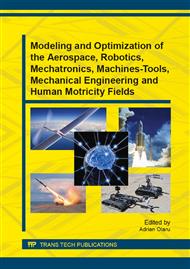[1]
Hirsch, M. W., Smale, S., and Devaney, R. L., Differential equations, dynamical systems and an introduction to chaos, Academic Press, Amsterdam, Boston, Heidelberg, New York, (2004).
Google Scholar
[2]
Halanay, A., and Răzvan, V. Applications of Liapunov Methods in Stability, Kluwer Academic Publishers, Dordrecht, Boston, London, (1993).
Google Scholar
[3]
Hayashi, C., Nonlinear Oscillations in Physical Systems, Ed. McGraw - Hill Book Company, New York, San Francisco, Toronto, London, (1964).
Google Scholar
[4]
Voinea, R. and Stroe, I. V., Introduction in dynamic systems theory, Academy Printing House, Bucharest, (2000).
Google Scholar
[5]
Migdalovici, M. and Baran, D., Vibration Control of some dynamic systems, BREN Printing House, Bucharest, (2006).
Google Scholar
[6]
Migdalovici, M. and Baran, D., On a method of vibration analysis for dynamical systems, Topics in Applied Mechanics, vol. I, cap. 9, Academy Printing House, Bucharest, (2003).
Google Scholar
[7]
Migdalovici, M. and Baran, D., About the stability of motion for two sprung superposed masses in contact with a wire, Proceedings ICSV10, Stockholm, pp.2147-2154, (2003).
Google Scholar
[8]
Migdalovici, M. and Baran, D., On a stability analysis method of dynamical systems with numerical tests, Proceedings of the Int. Conf. of Diff. Geom. and Dynamical Systems (DGDS-2008), Mangalia, Romania, pp.99-107, Geometry Balkan Press, (2009).
Google Scholar
[9]
Chung, Y. I. and Genin, J., Stability of a vehicle on a multispan simply supported guideway, J. of Dynamic Systems, Measurements and Control, 100, pp.326-331, (1978).
DOI: 10.1115/1.3426385
Google Scholar
[10]
Poetsch, G. and all.,. Pantograph/ Catenary Dynamics and Control, Vehicle System Dynamics, 28, pp.159-195, (1997).
DOI: 10.1080/00423119708969353
Google Scholar
[11]
Migdalovici, M., Sireteanu, T. and Videa, E. M., Control of Vibration of Transmission Lines, International Journal of Acoustics and Vibration, 15 (2), p.65–71, (2010).
DOI: 10.20855/ijav.2010.15.2259
Google Scholar
[12]
Kumaniecka, A. and Grzyb, A., On Dynamics of Catenary / Pantograph Modeled as Discrete Dynamic System, Machine Dynamics Problems, 24, pp.105-119, (2000).
Google Scholar
[13]
Migdalovici, M., Baran, D., Vladeanu, G., On the separation conditions of the stability zones of the dynamical systems that depend of parameters, The 20th International Congress on Sound and Vibration ICSV20, Bangkok, Thailand, 7-11 July, 2013 (Proceedings on CD).
Google Scholar
[14]
Zeveleanu C., Bratu P., Non linear vibrations, Impuls Printing House, Bucharest, (2001).
Google Scholar
[15]
Migdalovici, M., Baran, D., Vladeanu G., Dynamic systems stability, Self-Publishing Printing House, Bucharest, (2013).
Google Scholar
[16]
Wilkinson, J. H., Convergence of the LR, QR and related algorithms, Computer J. 8, pp.77-84, (1965).
Google Scholar
[17]
Rutishauser, H., Computational aspects of F.L. Bauer's simultaneous iteration method, Numer. Math., 13, (1969).
Google Scholar
[18]
Francis, J. G. F., QR Transformation, The Computer Journal, 4, First part, pp.265-271, (1961), Second part, pp.332-345, (1962).
Google Scholar
[19]
Parlet, B.N., Global convergence of the basic QR algorithm on Hessenberg matrices, Math. of Computation 22, p.803—817, (1968).
DOI: 10.2307/2004579
Google Scholar
[20]
Vladeanu, Al., The study of the dynamic loadings in the traveling mechanism of digging and transportation machines with hydrostatic driving, Doctoral thesis, Bucharest Buildings University, Bucharest, (1986).
Google Scholar
[21]
Lacroix, B. et al., A comparison of two control methods for vehicle stability control by direct yaw moment, Applied Mechanics and Materials, 120, pp.203-217, (2011).
DOI: 10.4028/www.scientific.net/amm.120.203
Google Scholar
[22]
Wang, P. et al., Research on walking stability of quadruped search-rescue robot, Applied Mechanics and Materials, 63-64, pp.831-834, (2011).
DOI: 10.4028/www.scientific.net/amm.63-64.831
Google Scholar
[23]
Appala T. et al., Tip over stability analysis of a three-wheeled mobile robot capable of traversing uneven terrains without slip, Applied Mechanics and Materials, 110-116, pp.2940-2947, (2011).
DOI: 10.4028/www.scientific.net/amm.110-116.2940
Google Scholar


